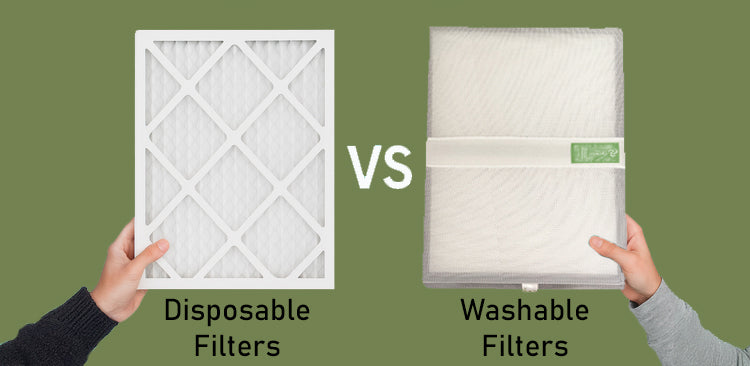
Washable Furnace Filters vs Disposable: Which Is Better?
| Danika VDM
Washable Furnace Filters vs Disposable: Which Is Better?
Let’s be honest: furnace filters aren’t exactly the most riveting conversation. But behind that filter slot in your furnace (or wall/ceiling vent, if you're in the South) is a choice that affects your home’s air quality, your wallet, and yes — your environmental footprint.
In Canada, where heating systems run half the year (or more), it’s easy to underestimate just how many disposable filters we go through. Most homeowners swap them out 4–6 times per year — and that adds up fast. Both in cost and in trash.
So, should you stick with the tried-and-trashed disposable filter? Or is it finally time to make the switch to a washable option?
What Are Disposable Furnace Filters, Really?
Disposable filters look simple: a cardboard frame with a white mesh or webbed/fluffy interior. But peel one apart and you’ll discover it’s not just “paper.” That filtering layer is usually a spun plastic — a synthetic polymer that’s fused to the cardboard. It does a decent job at capturing dust and particles, but it’s actually plastic. And that’s a bit of a double-edged sword.
Translation? It’s non-recyclable. It’s plastic. And it’s heading straight to landfill every few months. No municipal recycling programs in Canada or the U.S. accept used furnace filters.

Multiply that by millions of homes, each burning through multiple filters per year, and the environmental cost becomes pretty hard to ignore.
The Eco (and Economic) Case for Washable Filters
A high-quality washable filter, like the Cycle Air filter, is designed to last years, not weeks.
At first glance, the price tag might seem steep. A good disposable costs $15–$25. A washable? $99–$150 CAD ($70–$95 USD), depending on the brand, type, MERV rating, and size. But break that down over the lifetime of the filter (or even just 1–3 years), and you’re spending less per year — while keeping plastic filters out of the garbage.
Let’s do the math. Do washable furnace filters save money?
| Filter Type | Annual Cost | 3-Year Cost | 8-Year Cost |
|---|---|---|---|
| Disposable Furnace Filter | ~$60–100 | ~$180–300 | ~$480–800 |
| Washable Furnace Filter | ~$99–150 | ~$99–150 | ~$99–150 |
That’s not even factoring in the carbon footprint of manufacturing and shipping those disposables over and over — or your time reordering filters and guessing sizes.
How Do Washable Filters Work?
Not all washable filters are created equal. Some rely on outdoor hose-downs with degreasers (so fun in -20°C weather). Others need special sprays or hours of drying time.
Cycle Air’s washable filter works differently. Remove the filter media, toss it in the washing machine, dry it, and reinstall — same day. It’s made from recycled performance mesh, sewn in Canada, with a patented change indicator that tells you when it’s time to clean. No hose, no sprays, no freezing your fingers in February.

But What About Air Quality?
This is a common concern: “If it’s washable, does it really work?”
Cycle Air’s filters are MERV 7 — ideal for residential homes. That means they:
- · Capture dust, pet hair, pollen, and mold spores
- · Protect your HVAC system from buildup
- · Maintain strong airflow (unlike ultra-dense filters that choke your system)
MERV ratings can be confusing. MERV 11 or 13 filters can trap smaller particles like smoke — but they often come at the cost of restricted airflow (aka static pressure). In fact, only about 20% of smoke particles are captured by MERV 11. And many HVAC systems aren’t designed to handle those higher-resistance filters.
Most homes will get the best (most balanced) benefit from a MERV 6–8 filter — capturing the majority of household dust and allergens, without straining the blower motor.
Pro tip: If you live with smokers, wildfires, or severe asthma, supplement your HVAC system with a HEPA air purifier in main living and sleeping areas. You’ll get better results than trying to turn your furnace filter into a hospital-grade unit. Why? Anything under MERV 10 doesn't capture smoke (called "E1 particulates" in the industry) and for that matter, MERV 11 only captures 20%. So most experts will agree that trying to use your furnace to be a whole-home air purifier for smoke is not the most efficient use of energy. It can strain your blower and cause premature wear/shorten its lifespan.
Lastly, washable filters only work well when you clean them. That’s where Cycle Air wins — it’s easy to wash, so you’ll actually do it. And a clean filter always outperforms a forgotten one.
A Better Option for…
Eco-conscious families: You’ve swapped to reusable grocery bags, shampoo bars, and compost bins. Why stop at your air filter?
Pet owners: If you’ve got a Golden Retriever (or three), you know how fast filters clog. Cycle Air makes it easy to clean and reset — without last-minute hardware store trips.
Budget-minded homeowners: After year one, you’re saving money. Period.
People tired of waste: There’s something satisfying about using a product built to last — especially when it performs just as well as the disposable kind.

Want to Learn More?
If this post resonated with you, check out these helpful reads:
- 🔗 Are Washable Furnace Filters Worth It? Pros, Costs, and Long-Term Benefits
- 🔗 What is MERV? And What Rating Do You Actually Need for Your Home?
Final Verdict
It’s not just about saving money — it’s about stopping a silent stream of plastic from slipping into landfill, filter by filter.
Washable filters like Cycle Air are better for the planet, easier on your wallet, and — if we’re honest — kind of a no-brainer.
Ready to see if your size is in stock? Shop the Cycle Air washable filter by size in our handy Size Guide.
